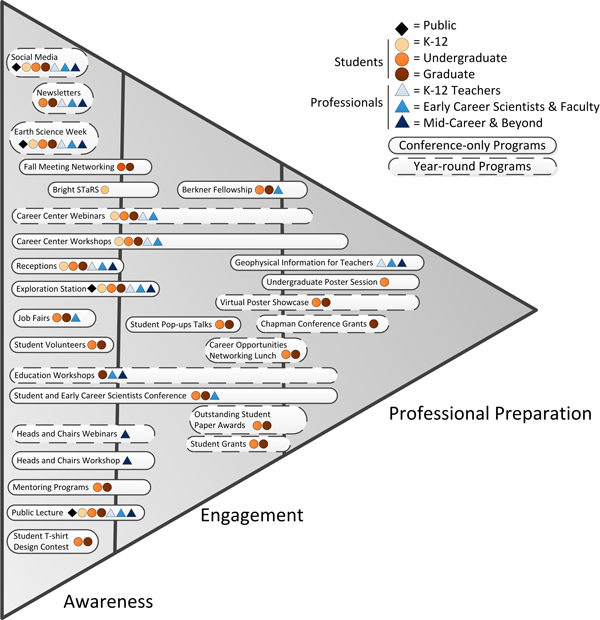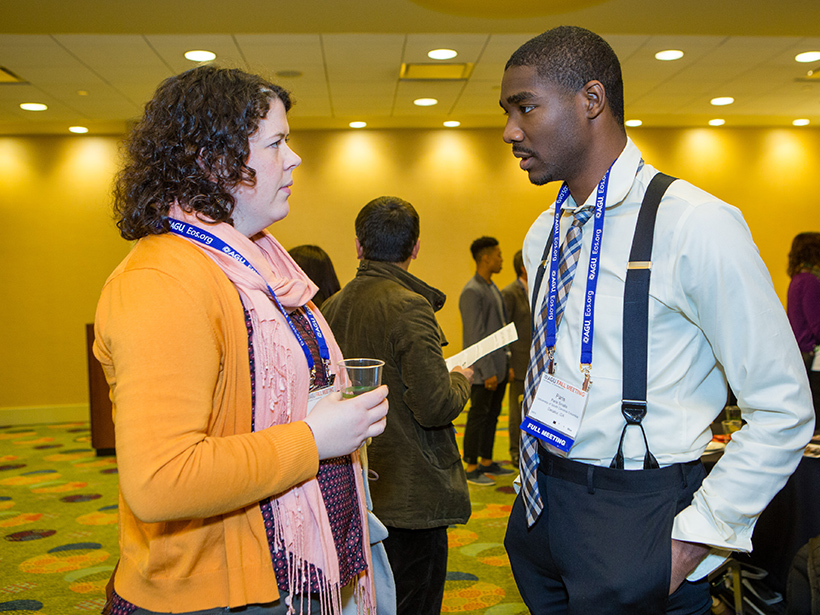What attracts individuals to the Earth sciences and prepares them for employment? Entry into the Earth and space science workforce often involves a complex, individualized pathway. It requires training and time. It also requires commitment from academic institutions, faculty, and mentors, as well as engagement with professional societies.
AGU engages several distinct audiences at a variety of career and professional stages via a suite of programs at conferences and throughout the year.
In a recent National Research Council (NRC) study, the Committee on Trends and Opportunities in Federal Earth Science Education and Workforce Development considered a conceptual framework of a system of opportunities and experience. In this triangular framework, many individuals first “became aware of Earth science.” A small fraction of these “engage in learning the field,” and an even smaller percentage of individuals “eventually prepare for a career by acquiring specialized knowledge, skills, and expertise and by exploring different employment options.”
The American Geophysical Union (AGU) engages several distinct audiences at a variety of career and professional stages via a suite of programs at conferences and throughout the year. These programs include workshops about teaching strategies, networking events for students, student conferences, virtual poster showcases for undergraduate and graduate students, and events for the public.
At first glance, these programs might appear to be unrelated, but placing this suite of programs into the NRC framework makes the connectivity clear. The programs serve different audiences, and the connections will help students and young scientists engage and bring the preparation they may need for advancing to the next step in their geoscience career. The wide range of programs enables an individual to become involved with AGU at any time “from K to gray.”

Diverse Pathways
A recent report by the National Academy of Sciences notes that students enter science, technology, engineering, and math (STEM) careers from a complex array of diverse pathways rather than a linear “STEM pipeline.” However, three levels of involvement are typical: awareness, engagement, and professional preparation (Figure 1).
Students at various levels of involvement and progress can further their careers and engage with AGU using a variety of resources from AGU’s suite of Talent Pool programming. Here are a few examples:
Undergraduate Student A attended the 2015 AGU Fall Meeting and participated in the Mentoring Program but can’t make it to the 2016 meeting because of funding limitations.
- Are you a senior looking for your next step? Explore AGU’s Career Center and sign up for webinars.
- Do you have research findings to share? Participate in the Virtual Poster Showcase or apply for a Student Travel Grant for a future AGU meeting.
- Can you reconnect with your mentor from last year? Send your mentor an email to get back in touch.
Undergraduate Student B is planning to attend Fall Meeting for the first time in 2016.
- Thinking about what’s next? When you register, sign up to attend the Career Opportunities Networking Lunch, and consider arriving early for the Student and Early Career Scientists Conference. When you are at the meeting, make sure you attend the Public Lecture to learn about a hot topic in the field.
- Is graduate school your next step? Participate in the Outstanding Student Paper Awards and get noticed by potential graduate advisers. Apply for some one-on-one guidance in our Fall Meeting Undergraduate Mentoring Program. Attend Student Pop-Up Talks at Fall Meeting and learn more about the multiple dimensions of geoscience research.
- Don’t stop after Fall Meeting! Sign up for emails from sections/focus groups, the Education Special Interest Group, and the Career Center. Next year, consider participating in the Virtual Poster Showcase to share your latest research findings.
Graduate Student C went to the AGU Ocean Sciences Meeting in 2016 and left completely overwhelmed. Now this student is preparing to head to the Fall Meeting without his or her adviser.
- Plan ahead. Arrive at Fall Meeting a day early and attend the Student and Early Career Scientists Conference. Check out all of the student events, network with peers at the Student Mixer, and consider signing up for a time slot to chat with a seasoned AGU member early in the week.
- On a budget? Check out our suggestions on how to save money. Consider working as a student volunteer, apply for student travel grants or scholarships, and find other students who are interested in sharing a room.
- Passionate about teaching? Attend as many education-related events as possible at Fall Meeting. Attend the Job Fair—even if you aren’t looking yet—to get an idea about what opportunities are out there.
AGU’s Talent Pool programs provide numerous awareness, engagement, and professional preparation opportunities for students and early-career Earth and space scientists. Career paths are often disjointed and nonlinear, but the suite of programming is designed to provide a series of touch points between students and AGU at any point in the calendar year.
Mentors must make it clear: The onus is on you, the student, to determine which programs best meet your needs and career goals.
Mentors must make it clear: The onus is on you, the student, to determine which programs best meet your needs and career goals. For students who have not yet developed any career goals, focusing on awareness and engagement programs is a great place to start. Faculty, mentors, and department chairs play an integral role by helping students find the right opportunities for their advancement, whether that be a research project or entering the workforce.
—Pranoti M. Asher, Education and Public Outreach Manager, AGU; email: [email protected]; Claire Wilson, Education Intern, AGU; Erik Hankin, Student Programs Manager, AGU; and David Harwell, Talent Pool Assistant Director, AGU
Citation:
Asher, P. M.,Wilson, C.,Hankin, E., and Harwell, D. (2016), AGU Talent Pool programs can help students with next career steps, Eos, 97, https://doi.org/10.1029/2016EO054095. Published on 13 June 2016.
Text © 2016. The authors. CC BY-NC-ND 3.0
Except where otherwise noted, images are subject to copyright. Any reuse without express permission from the copyright owner is prohibited.

